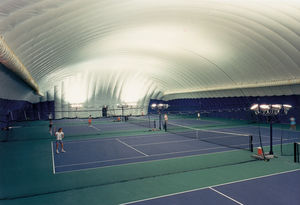
Tennis court inflatable structure BEIJING




Add to favorites
Compare this product
Characteristics
- Market
- for tennis court
Description
While the origins of the sport lie in Western cultures, tennis has become a very popular sport in China. It has been reported that as many as 14 million Chinese are regular tennis players on the 30,000+ tennis courts in the country. The number of participants continues to grow at a rate approaching 15% per year, resulting in a business segment driving an exchange of $15B annually.
The ever increasing number of tennis players, coupled with its TV presence (3rd most popular sport on Chinese TV), has increased the demand for additional, easily accessible facilities. In much of the country, outdoor courts are only useable for a portion of the year, and building hard shell tennis enclosures is often cost prohibitive. The use of architectural fabrics for building construction is increasing in popularity worldwide, particularly in China. For instance, there were 15 outdoor tennis courts within Beijing Sun Park, none of which were enclosed. As a result, tennis enthusiasts were being shut-out from their favorite pastime in inclement weather.
In 2006, The Sun Park Tennis Club was constructed within Beijing Sun Park using a pressurized air structure made from an architectural fabric by Seaman Corporation. This design concept relies on low air pressure to inflate and secure a large permanent structure, providing wind and snow load carrying capability as a result of the tension provided by the pneumatic pressure. The 4000 sq. meter structure houses six tennis courts in a fully environmentally controlled facility for year-round indoor use.
*Prices are pre-tax. They exclude delivery charges and customs duties and do not include additional charges for installation or activation options. Prices are indicative only and may vary by country, with changes to the cost of raw materials and exchange rates.




